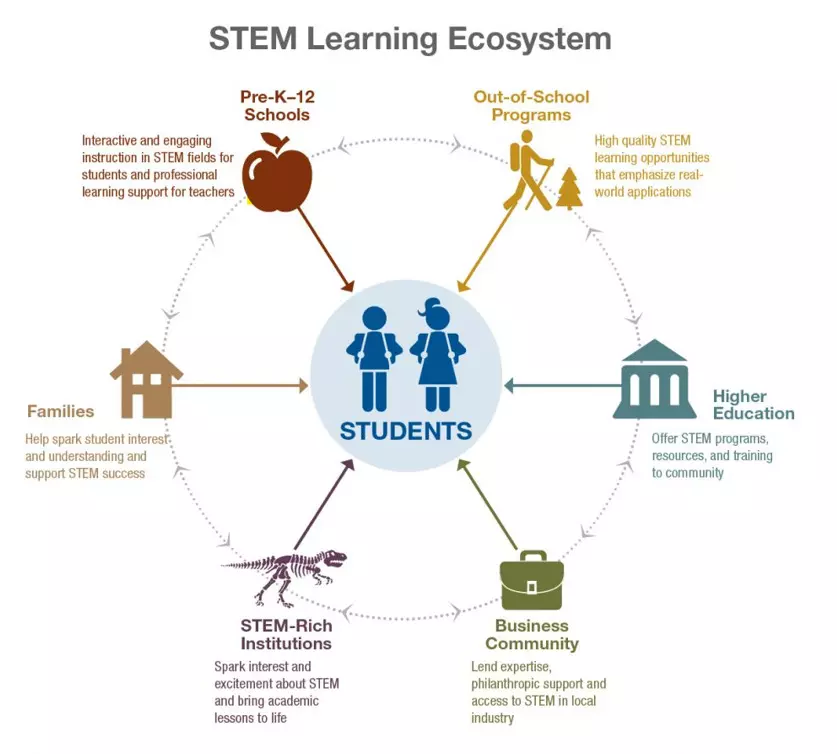Unfurling new vistas
Dynamic and ethics-based integration of STEM in engineering education is enabling students to emerge as future-ready professionals and citizens contributing immensely to economic growth

STEM is a subject of study focused on four crucial academic fields including science, technology, engineering, and math. The National Science Foundation (NSF) of the United States developed the abbreviation STEM in 2001. Since then, programmes have been formed in nations outside of the United States, including Australia, China, France, South Korea, Taiwan, and the United Kingdom, all of which have STEM-focused curricula.
The technical disciplines of science, technology, engineering, and mathematics are distinct yet connected. The phrase is frequently used in reference to curricular options or educational policies in schools. It has ramifications for national security issues, workforce development, and immigration policy in relation to admitting international students and tech professionals.
Following the release of numerous significant reports, the fields of science, technology, engineering, and mathematics (STEM) became more integrated in the United States in the early 2000s. In particular, the US National Academies of Research, Engineering, and Medicine's study from 2005, Rising Above the Gathering Storm, highlighted the connections between affluence, knowledge-intensive occupations depending on research and technology, and ongoing innovation to solve social concerns. Pupils in other nations were outperforming American pupils in STEM fields at a faster rate. If the nation could not compete in the global economy as a result of a poorly trained workforce, the research foresaw severe implications. Research in the fields of science, mathematics, and technology, as well as economic policy and education, were thus the centre of attention.
Results from international studies like PISA (Programme for International Student Assessment), a triennial assessment of knowledge and skills among 15-year-olds, and TIMSS (Trends in International Mathematics and Science Study), a periodic international comparison of mathematics and science knowledge of fourth and eighth graders, have confirmed American concerns. According to PISA 2006 findings, the United States had a disproportionately high percentage of underperforming students and was ranked 21st out of 30 nations in scientific knowledge and proficiency tests. STEM education goes beyond traditional subject-specific teaching and encourages students to think critically, solve problems creatively, and apply knowledge in real-world scenarios.
By engaging students in hands-on projects and experiments, STEM makes them learn to identify challenges, seek solutions, and make informed decisions. These skills are invaluable in addressing complex issues in fields such as technology, medicine, and environmental sustainability.
STEM fields have historically lacked diversity, with underrepresented groups facing barriers to entry. STEM education initiatives aim to bridge this gap by promoting inclusivity and encouraging underrepresented individuals, including women and minorities, to pursue careers in these fields. STEM-related industries are major drivers of economic growth and job creation. A robust STEM education system produces a skilled workforce equipped to meet the demands of emerging industries such as artificial intelligence, biotechnology, and renewable energy. STEM education nurtures innovation and entrepreneurship, encouraging students to develop ground-breaking technologies and solutions. Innovations originating from STEM research have the potential to revolutionize industries, create new markets, and lead to economic prosperity.
The world faces numerous challenges, including climate change, pandemics, and resource scarcity. STEM education encourages young minds to tackle these issues through sustainable solutions, data-driven insights, and collaborative efforts.
Advancements in medical technology and research are critical for improving healthcare and saving lives. STEM-educated professionals play pivotal roles in medical breakthroughs, drug development, and healthcare innovations, ultimately enhancing the quality of life for millions.
Over the years, there have been significant developments and initiatives that promote the integration of STEM principles into engineering education, resulting in several key advancements of Bloom's Taxonomy.
Project-based learning: Engineering education has shifted towards a more hands-on, project-based approach. Students engage in real-world engineering challenges, working collaboratively to design, prototype, and implement solutions.
Interdisciplinary integration: The advancements of STEM in engineering education have encouraged the integration of multiple disciplines. Engineering students now gain exposure to diverse fields such as computer science, biology, and materials science, fostering a holistic approach to problem-solving.
Use of advanced technologies: Virtual and augmented reality simulations, 3D printing, and computer-aided design tools provide students with hands-on experiences, making engineering concepts more tangible and relevant.
Focus on ethical and social impact: Engineering students are encouraged to consider the ethical implications of their designs, ensuring their innovations contribute positively to society and address global challenges.
Research opportunities: Universities and institutions offer research programs and opportunities to work with faculty members on cutting-edge projects, fostering innovation and encouraging students to pursue higher degrees.
Entrepreneurship and innovation: Engineering programs now offer courses on innovation, product development, and entrepreneurship, empowering students to turn their ideas into viable businesses and start-ups.
Industry partnerships: Collaborations with industry leaders provide students with exposure to real-world projects and challenges, bridging the gap between academic knowledge and industry practices.
Diversity and inclusion: Focused advancements in engineering education have also led to increased efforts to promote diversity and inclusion. Educational institutions are striving to create more inclusive environments, encouraging underrepresented groups to pursue engineering careers and contribute to the field's growth.
Online and distance learning: STEM advancements have facilitated the adoption of online and distance learning platforms in engineering education. These flexible learning options enable students from diverse backgrounds and locations to access quality engineering education.
Lifelong learning: Continuous advancements in STEM have underscored the importance of lifelong learning for engineering professionals. Engineers are encouraged to stay abreast of the latest technologies and industry trends through workshops, webinars, and professional development courses.
The integration of STEM principles in engineering education has transformed the learning landscape, empowering engineering students with the skills and mindset needed to thrive in a rapidly evolving world. Through project-based learning, interdisciplinary integration, and a focus on ethical and social impact, students are better prepared to contribute meaningfully to society and drive innovation in their respective fields.
The writer is Professor of Computer Science and Engineering, Sister Nivedita University. Views expressed are personal



